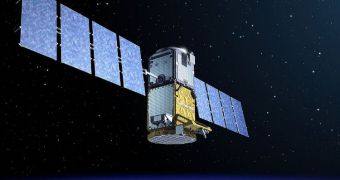The second Galileo In-Orbit Validation Element satellite, known as GIOVE-B, is currently being prepared by mission controllers at the European Space Agency (ESA) for a well-deserved retirement.
The spacecraft transmitted its first data to ESA on May 7, 2008, after launching on April 27, aboard a Russian-built Soyuz-FG delivery system with a Fregat upper stage. Takeoff occurred from the Baikonur Cosmodrome, in Kazakhstan.
The purpose of this experimental satellite was to test the science equipment necessary for satellites that would constitute the upcoming ESA Galileo satellite navigation and positioning network. In the meantime, the first two Galileo spacecraft were launched from South America last year.
GIOVE-B was designed to conduct a 4-year mission, which has now concluded. Experts at ESA are currently changing its flight trajectory, taking it to a graveyard orbit where it will pose no threat to other, still-operating satellites.
A thruster-firing maneuver occurred yesterday, July 24, when the satellite's orbit was boosted by about 30 kilometers (18.6 miles). Over the next three weeks, all the way to mid-August, a series of engine burns will raise its current altitude by about 600 kilometers (372.8 miles).
Originally, the vehicle was injected in a 23,222-kilometer (14,430-mile) orbit. This altitude was determined to be perfect for the rubidium clock GIOVE-B was carrying. The instrument is accurate to within three seconds over the course of 1 million years.
“GIOVE-B, like its predecessor GIOVE-A, performed excellent work testing Galileo hardware, securing Europe’s rights to the radio frequencies set aside for Galileo and gathering data on medium-Earth orbit conditions,” ESA GIOVE satellite manager Valter Alpe says.
“Its signal, in combination with its ground element, also served to prove the Galileo system will work as planned,” the European official explains. He adds that GIOVE-B also played a significant role in testing connections between Galileo satellites and listening stations at various locations on Earth.
“But now that the first Galileo satellites have joined them in orbit – with the first two launched together on 21 October 2011, and a second pair due this autumn – and have proven to be operating extremely well – there is no longer any role left for these experimental satellites,” Alpe concludes.

 14 DAY TRIAL //
14 DAY TRIAL //